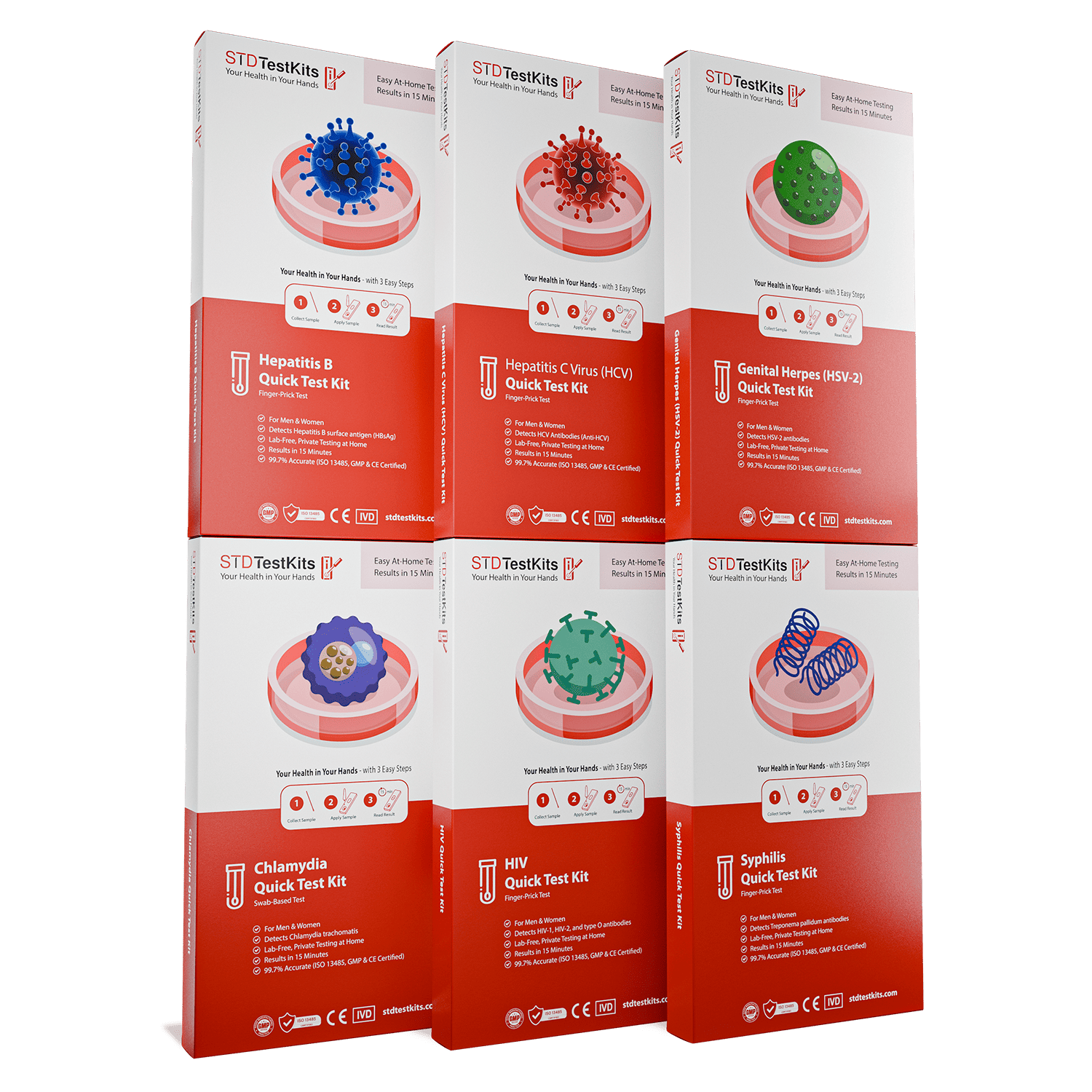My STD Symptoms Vanished. Was I Cured, Or Just Lucky?
Quick Answer: After syphilis exposure, the bacteria Treponema pallidum incubates for 10–90 days (on average ~21 days). The first sign is usually a painless sore (chancre) at the contact site. In the first 30 days, you may see nothing, or you may notice the first sore. Testing before 3 weeks is often too early.
Why the First 30 Days Matter
Here’s the catch: syphilis doesn’t hit instantly. Unlike gonorrhea or chlamydia, which can cause symptoms within days, syphilis takes its time. That delay creates false confidence for many people. They think, “It’s been two weeks and I feel fine, I must be safe.” In reality, the infection may just be incubating, waiting to show itself.
The first month is the gray zone. Your body may not react right away. Tests may not pick it up yet. And that silence is exactly what lets syphilis spread so easily through communities.

People are also looking for: What Syphilis Looks Like in Newborns (And Why It’s Often Missed)
What’s Happening Inside Your Body
Syphilis spreads through direct contact with a sore during sex, oral, vaginal, or anal. Once the bacteria slip past the skin or mucous membrane, they multiply locally. Then they spread through the lymphatic system and bloodstream. But you won’t feel that happening.
During this incubation phase, most people experience no symptoms at all. If a sore does develop, it usually shows up around day 21, but it could appear earlier or later depending on your immune response and the size of the initial infection.
Timeline: Days 1–30 After Exposure
Figure 1: The first 30 days after syphilis exposure, and why you might not see symptoms even when the infection is active.
Why You Might Miss It
The syphilis sore, called a chancre, doesn’t behave like most infections. It’s painless, round, and firm. That means it doesn’t throb or itch like a herpes blister. If it’s inside your mouth, on your tonsils, under the foreskin, or inside the vagina, you might never notice it.
Even scarier? The sore eventually heals on its own, usually within 3–6 weeks. People see it disappear and assume they dodged the bullet, when in reality, the infection is just advancing to the next stage.
Testing in the First 30 Days: What You Need to Know
When you’ve just been exposed, the urge to test immediately is overwhelming. You want answers now. But syphilis doesn’t work on your timeline. Test too early, and the results could be misleading.
Syphilis tests look for antibodies, your body’s immune response to the bacteria. The problem is, antibodies don’t appear instantly. It can take 3 to 6 weeks for your body to produce enough to show up on a test. That means the first 30 days are a dangerous limbo zone.
False Negatives: The Early Trap
If you test within the first 2 weeks after exposure, chances are high you’ll get a false negative. Not because the test is broken, but because your body hasn’t had time to react yet. Think of it like pregnancy tests: testing too early won’t give you an accurate answer, even if the process has already begun.
That’s why public health guidelines recommend retesting later, even if your first test is negative. A single test within 30 days can’t clear you completely.
Figure 2: Testing accuracy improves with time after exposure. Retesting is key for reliable results.
What Early Symptoms Look Like (And Why They’re Missed)
Here’s the cruel part: even when symptoms do show up in the first 30 days, they’re easy to ignore. A syphilis chancre isn’t dramatic. It doesn’t burn or ooze. It’s painless, small, and firm. Many people mistake it for a pimple, an ingrown hair, or a harmless canker sore if it’s in the mouth.
Other subtle early signs include:
- Swollen lymph nodes near the sore (groin, neck, or armpits)
- A sore throat without cold or flu symptoms
- Tiny ulcers inside the mouth or on the genitals
But the sore usually fades in a few weeks, even without treatment. That’s the danger, people think they’ve healed, when really the infection has just moved into the bloodstream.
The Psychology of Waiting
Waiting 6 weeks to test feels unbearable when you’re panicking about a recent hookup. Anxiety kicks in:
“Am I already infected? What if I give it to someone else? What if I never know?”
This is where most people either over-test too early or avoid testing altogether because they can’t face the possibility.
The truth is, both extremes are harmful. Over-testing wastes time and money and can lull you into false reassurance. Avoiding testing entirely lets the infection spread silently. The middle ground, testing at the right time, is what gives you real control.

People are also reading: Think It’s Just a Skin Thing? Syphilis Rashes Are Trickier Than You Think
So What Should You Actually Do in the First 30 Days?
Here’s a realistic plan:
- If you’re within 2 weeks of exposure: testing is too early, but you can schedule one for later.
- If you’re at 3–4 weeks: get an initial test, but know you’ll need to repeat it at 6–12 weeks.
- If you notice a sore: get tested immediately, regardless of timing.
And remember, syphilis rarely travels alone. If you were exposed, you should also test for HIV, chlamydia, gonorrhea, and herpes. The same encounter that put you at risk for syphilis could expose you to these too.
What Happens If You Ignore the First 30 Days
Let’s say you don’t notice the sore. Or maybe you see it, panic for a week, then it fades. Relief, right? Wrong. That’s when syphilis makes its next move. The infection doesn’t disappear, it just spreads deeper, slipping into your bloodstream and lymph nodes.
This transition usually happens after the 30-day mark. That’s why the first month is such a critical window. What looks like “no problem” can actually be the setup for the secondary stage.
From Chancre to Bloodstream: The Silent Advance
The chancre is the launchpad. While it sits there looking harmless, the bacteria are multiplying. By the time it heals, the bacteria have already entered the bloodstream, spreading to other organs and tissues. This is how syphilis earns its nickname: the great imitator. Once it’s systemic, it can mimic dozens of other conditions.
What you might experience next, if anything, includes:
- A rash on your torso, arms, or palms
- Flu-like illness: low fever, fatigue, swollen glands
- Patchy hair loss
- Mouth or throat ulcers
But remember, these symptoms might not show up right away. They can appear weeks or months after the sore heals, or not at all. Some people coast straight into latency with zero obvious warning signs.
Why the First 30 Days Are a Fork in the Road
If you catch syphilis in the first month, treatment is simple: one shot of penicillin. That’s it. Problem solved. But if you miss it and it moves into secondary or latent stages, treatment becomes more complex, requiring multiple injections over weeks, and the risk of long-term complications rises.
This is why doctors and public health experts hammer home the importance of early testing. Every week that passes without detection increases the chances of transmission and late complications.
Real-World Scenarios: How People Miss the First 30 Days
Case 1: The Disappearing Sore
A man notices a small ulcer on his penis but assumes it’s friction. It heals in 3 weeks. He never tests. Months later, he develops a rash and swollen lymph nodes, and finally learns it was syphilis all along.
Case 2: The Mistaken Sore Throat
A woman develops a painless ulcer on her tonsil after giving oral sex. Her doctor diagnoses strep throat and prescribes antibiotics that don’t treat syphilis. Six months later, she’s back with systemic symptoms.
Case 3: The False-Negative Test
A guy tests for syphilis 10 days after exposure, negative. He relaxes, doesn’t retest, and unknowingly carries syphilis into the latent stage. Years later, he learns the truth during a routine screening.
The Cost of Delay
Syphilis doesn’t just hurt you. It spreads. The first 30 days are when you’re most likely to expose partners without knowing. Chancres are loaded with bacteria, and because they’re painless, people don’t realize they’re contagious. By missing that early window, you increase the risk of passing it on.
So, What Should You Watch for as the Days Tick By?
If you’re in the “just exposed” zone, here’s what’s worth tracking:
- Weeks 1–2: No symptoms, but incubation underway.
- Weeks 2–3: Look for a single sore at the contact site. It won’t hurt, so check carefully.
- Weeks 3–4: If a sore appeared, it may already be healing. Don’t mistake this for recovery.
If nothing shows up, don’t let that fool you. Many infections remain invisible in the first 30 days. That’s why testing later is so crucial.
Retesting Plan: Making the Waiting Game Bearable
Here’s the simplest approach if you’ve just had a possible exposure:
- Week 3–4: Optional early test, especially if you see a sore
- Week 6: Main test, high accuracy at this point
- Week 12: Final confirmation, especially if no treatment was given
This way, you don’t stay in limbo. You’ll get answers, and if something shows up, you can handle it early.

People are also reading: Why Syphilis Is Spiking Among Straight Men, and Why It Matters
FAQs
1. Can syphilis show up right away, like the next day?
Nope. Syphilis takes its sweet time. The sore (chancre) usually doesn’t appear until at least 10 days in, often closer to 3 weeks. If you wake up the next morning with a bump, that’s irritation or something else, not syphilis.
2. What does the first sore actually look like?
Think “painless pimple that doesn’t heal.” It’s round, firm, and doesn’t ooze. Because it doesn’t hurt, people often ignore it or think it’s an ingrown hair. If it’s in your mouth, you might confuse it with a canker sore.
3. My sore disappeared after a few weeks. Am I in the clear?
I wish. That’s syphilis’s classic trick, the sore heals on its own. People breathe a sigh of relief, but the infection just goes underground. It’s not gone; it’s spreading.
4. Could I give syphilis to someone else in the first 30 days?
Yes. If you’ve got a sore, it’s loaded with bacteria and very contagious. Even kissing can spread syphilis if the sore’s in your mouth. No sore doesn’t always mean no risk, especially in the first year.
5. Is testing in the first 2 weeks a waste of time?
Kind of, yeah. Your body hasn’t had time to make antibodies yet, so the test might come back negative even if you’re infected. Testing that early is like showing up to a movie before the projector’s even turned on. You’ll need to retest later for real answers.
6. What if I never notice a sore at all?
That happens a lot. If the sore’s inside your rectum, vagina, or throat, you might never see or feel it. Many people skip straight to the later stages without knowing they were ever infected. That’s why routine screening is so powerful.
7. Can syphilis cause a sore throat in the first month?
Yes, if you got it from oral sex. A chancre on your tonsil looks a lot like strep throat. Doctors sometimes miss it unless they’re thinking about STDs, which means you could walk away misdiagnosed.
8. I tested negative at 3 weeks. Can I relax?
Not yet. A 3-week test is a good start, but it’s not the finish line. Retest at 6 weeks, and again at 12 if you want absolute closure. Early tests are like sneak previews, the full picture comes later.
9. If I do test positive this early, is treatment easy?
Yes, and that’s the good news. Catching syphilis early usually means one penicillin shot and you’re done. Ignore it, and treatment gets more complicated. Early action is the fast exit ramp.
10. I can’t stop spiraling, what should I do while I wait?
First: breathe. You’re not the first person to go through this, and you won’t be the last. If testing early calms you, do it, but commit to retesting later. Make a plan, mark the dates on your calendar, and remind yourself: getting tested isn’t about shame, it’s about taking back control.
Taking the Next Step
If you’re in the first 30 days after a risky encounter, you don’t need to sit in silence. Order a rapid syphilis test kit or book a clinic appointment. Even if it’s too early for final confirmation, you’ll feel more in control with a plan in place.
Don’t wait until syphilis decides to show itself. Take back the timeline.
How We Sourced This Article: This guide was written using CDC and WHO syphilis guidelines, peer-reviewed journals on incubation and testing windows, and case studies from STI clinics. We also drew from real patient experiences to highlight how easy it is to miss early symptoms.
Sources
1. Primary stage begins 10–90 days after infection, typically ~3 weeks – Medical News Today
2. Primary syphilis appears 10 days to 3 months post-infection – NHS Inform
3. Incubation 9–90 days (mean 30) to primary syphilis; secondary 30–150 days – ASHM
4. Primary chancre incubation 10–90 days, median 21–25 days – StatPearls
5. Syphilis incubation ~3 weeks (10–90 days); latent possible long dormancy – Verywell Health
About the Author
Dr. F. David, MD is a board-certified infectious disease physician specializing in STDs and community health. His writing focuses on stripping away shame while delivering hard science with compassion.
Reviewed by: Dr. M. Lee, MPH | Last medically reviewed: September 2025
This article is for educational purposes only and is not a substitute for professional medical advice. Always consult a provider for testing and treatment.







